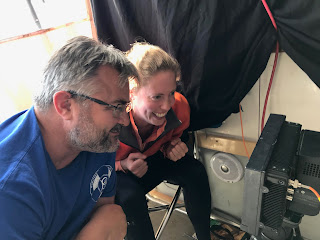The Palmer and Crary
 |
| The sea was so flat, I could barely find the horizon |
Last week, my team was back in Stellwagen Bank National Marine Sanctuary to sample a new shipwreck. We had worked out many of the kinks in our sampling strategy and were rewarded with two amazingly productive days. Altogether, we collected 10 glorious hours of ROV video footage and covered almost the entire wreck.
 |
| Watching the ROV video feed with Calvin, the project's archaeologist. My face says it all. Photo credit: Elizabeth Weinberg/NOAA. |
 |
| It's a grainy screenshot with glare, but you can see hydroids (stringy brown clumps) and sponges (yellow blobs) living on the rigging (old ropes) on the Palmer/Crary wreck. |
One exciting finding was that the outer hulls of the Palmer and Crary were gone, leaving the ribs of both ships exposed. I'll have to check the previous video, but I think they used to be intact. If my memory serves and the hulls were intact before, it means any animal living on the ribs had to have settled there since the year the footage was recorded. I can use this fact to estimate maximum ages and minimum growth rates for the species I'm seeing, including the glass sponges. Very little is known about sponge growth, settlement, etc., especially for deep-water species. The shipwrecks provide a rare opportunity to estimate difficult parameters and learn more about how the animals live.
It was a great week in Stellwagen Bank, and I'm excited to analyze the data!
Comments
Post a Comment